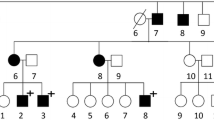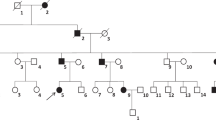Abstract
Background
Familial central diabetes insipidus (DI), usually an autosomal dominant disorder, is caused by mutations in arginine vasopressin-neurophysin II (AVP-NPII) gene that leads to aberrant preprohormone processing and gradual destruction of AVP-secreting cells.
Objective
To determine clinical and molecular characteristics of patients with familial central DI from two different Turkish families.
Materials and methods
The diagnosis of central DI was established by 24-h urine collection, water deprivation test, and desmopressin challenge. To confirm the diagnosis of familial central DI, the entire coding region of AVP-NPII gene was amplified and sequenced. A total of eight affected patients and three unaffected healthy relatives from two families were studied.
Results
Genetic analysis revealed a previously reported heterozygous mutation (p.C98X) in family A, and a heterozygous novel mutation (p.G45C) in family B, both detected in exon 2 of AVP-NPII gene. When we compared the clinical characteristics of the two families, it was noticed that as the age of onset of symptoms in family A ranges between 4 and 7 years, it was <1 year in family B. Additionally, pituitary bright spot was present in the affected siblings, but absent in their affected parents.
Conclusion
Familial central DI is a progressive disease, and age of onset of symptoms can differ depending on the mutation. Bright spot on pituitary MRI might be present at onset, but become invisible over time. Genetic testing and appropriate counseling should be given in familial cases of central DI to ensure adequate treatment, and to avoid chronic water deprivation that might result in growth retardation in childhood.



Similar content being viewed by others
References
Land H, Schutz G, Schmale H, Richter D (1982) Nucleotide sequence of cloned cDNA encoding bovine arginine vasopressin–neurophysin II precursor. Nature 295(5847):299–303
Sausville E, Carney D, Battey J (1985) The human vasopressin gene is linked to the oxytocin gene and is selectively expressed in a cultured lung cancer cell line. J Biol Chem 260(18):10236–10241
Arima H, Morishita Y, Hagiwara D, Hayashi M, Oiso Y (2014) Endoplasmic reticulum stress in vasopressin neurons of familial diabetes insipidus model mice: aggregate formation and mRNA poly(A) tail shortening. Exp Physiol 99(1):66–71. doi:10.1113/expphysiol.2013.072553
Elias PC, Elias LL, Torres N, Moreira AC, Antunes-Rodrigues J, Castro M (2003) Progressive decline of vasopressin secretion in familial autosomal dominant neurohypophyseal diabetes insipidus presenting a novel mutation in the vasopressin–neurophysin II gene. Clin Endocrinol 59(4):511–518
Mahoney CP, Weinberger E, Bryant C, Ito M, Jameson JL, Ito M (2002) Effects of aging on vasopressin production in a kindred with autosomal dominant neurohypophyseal diabetes insipidus due to the DeltaE47 neurophysin mutation. J Clin Endocrinol Metab 87(2):870–876. doi:10.1210/jcem.87.2.8270
Biasini M, Bienert S, Waterhouse A, Arnold K, Studer G, Schmidt T, Kiefer F, Cassarino TG, Bertoni M, Bordoli L, Schwede T (2014) SWISS-MODEL: modelling protein tertiary and quaternary structure using evolutionary information. Nucleic Acids Res 42(Web Server issue):W252–W258. doi:10.1093/nar/gku340
Arnold K, Bordoli L, Kopp J, Schwede T (2006) The SWISS-MODEL workspace: a web-based environment for protein structure homology modelling. Bioinformatics 22(2):195–201. doi:10.1093/bioinformatics/bti770
Kiefer F, Arnold K, Kunzli M, Bordoli L, Schwede T (2009) The SWISS-MODEL Repository and associated resources. Nucleic Acids Res 37(Database issue):D387–D392. doi:10.1093/nar/gkn750
Guex N, Peitsch MC, Schwede T (2009) Automated comparative protein structure modeling with SWISS-MODEL and Swiss-PdbViewer: a historical perspective. Electrophoresis 30(Suppl 1):S162–S173. doi:10.1002/elps.200900140
Brownstein MJ, Russell JT, Gainer H (1980) Synthesis, transport, and release of posterior pituitary hormones. Science 207(4429):373–378
Ito M, Yu RN, Jameson JL (1999) Mutant vasopressin precursors that cause autosomal dominant neurohypophyseal diabetes insipidus retain dimerization and impair the secretion of wild-type proteins. J Biol Chem 274(13):9029–9037
Russell TA, Ito M, Ito M, Yu RN, Martinson FA, Weiss J, Jameson JL (2003) A murine model of autosomal dominant neurohypophyseal diabetes insipidus reveals progressive loss of vasopressin-producing neurons. J Clin Investig 112(11):1697–1706. doi:10.1172/jci18616
Bergeron C, Kovacs K, Ezrin C, Mizzen C (1991) Hereditary diabetes insipidus: an immunohistochemical study of the hypothalamus and pituitary gland. Acta Neuropathol 81(3):345–348
Nagasaki H, Ito M, Yuasa H, Saito H, Fukase M, Hamada K, Ishikawa E, Katakami H, Oiso Y (1995) Two novel mutations in the coding region for neurophysin-II associated with familial central diabetes insipidus. J Clin Endocrinol Metab 80(4):1352–1356. doi:10.1210/jcem.80.4.7714110
Baglioni S, Corona G, Maggi M, Serio M, Peri A (2004) Identification of a novel mutation in the arginine vasopressin–neurophysin II gene affecting the sixth intrachain disulfide bridge of the neurophysin II moiety. Eur J Endocrinol 151(5):605–611
DiMeglio LA, Gagliardi PC, Browning JE, Quigley CA, Repaske DR (2001) A missense mutation encoding cys(67) → gly in neurophysin ii is associated with early onset autosomal dominant neurohypophyseal diabetes insipidus. Mol Genet Metab 72(1):39–44. doi:10.1006/mgme.2000.3117
Rittig S, Robertson GL, Siggaard C, Kovacs L, Gregersen N, Nyborg J, Pedersen EB (1996) Identification of 13 new mutations in the vasopressin–neurophysin II gene in 17 kindreds with familial autosomal dominant neurohypophyseal diabetes insipidus. Am J Hum Genet 58(1):107–117
Chen LQ, Rose JP, Breslow E, Yang D, Chang WR, Furey WF Jr, Sax M, Wang BC (1991) Crystal structure of a bovine neurophysin II dipeptide complex at 2.8 A determined from the single-wavelength anomalous scattering signal of an incorporated iodine atom. Proc Natl Acad Sci USA 88(10):4240–4244
Ito M, Jameson JL, Ito M (1997) Molecular basis of autosomal dominant neurohypophyseal diabetes insipidus. Cellular toxicity caused by the accumulation of mutant vasopressin precursors within the endoplasmic reticulum. J Clin Investig 99(8):1897–1905. doi:10.1172/jci119357
Hayashi M, Arima H, Ozaki N, Morishita Y, Hiroi M, Ozaki N, Nagasaki H, Kinoshita N, Ueda M, Shiota A, Oiso Y (2009) Progressive polyuria without vasopressin neuron loss in a mouse model for familial neurohypophysial diabetes insipidus. Am J Physiol Regul Integr Comp Physiol 296:1641–1649
Birkegaard C, Christensen JH, Falorni A, Marzotti S, Minarelli V, Gregersen N, Rittig S (2013) A novel variation in the AVP gene resulting in familial neurohypophyseal diabetes insipidus in a large Italian kindred. Pituitary 16(2):152–157. doi:10.1007/s11102-012-0392-x
Batista SL, Moreira AC, Antunes-Rodrigues J, Castro M, Elias LL, Elias PC (2010) Clinical features and molecular analysis of arginine-vasopressin neurophysin II gene in long-term follow-up patients with idiopathic central diabetes insipidus. Arquivos brasileiros de endocrinologia e metabologia 54(3):269–273
Brachet C, Birk J, Christophe C, Tenoutasse S, Velkeniers B, Heinrichs C, Rutishauser J (2011) Growth retardation in untreated autosomal dominant familial neurohypophyseal diabetes insipidus caused by one recurring and two novel mutations in the vasopressin-neurophysin II gene. Eur J Endocrinol 164(2):179–187. doi:10.1530/eje-10-0823
Author information
Authors and Affiliations
Corresponding author
Ethics declarations
Financial support/disclosure
This research was funded by the Scientific and Technological Research Council of Turkey (SBAG Project No: 112S513).
Conflict of interest
Authors have no conflict of interest.
Rights and permissions
About this article
Cite this article
Turkkahraman, D., Saglar, E., Karaduman, T. et al. AVP-NPII gene mutations and clinical characteristics of the patients with autosomal dominant familial central diabetes insipidus. Pituitary 18, 898–904 (2015). https://doi.org/10.1007/s11102-015-0668-z
Published:
Issue Date:
DOI: https://doi.org/10.1007/s11102-015-0668-z




